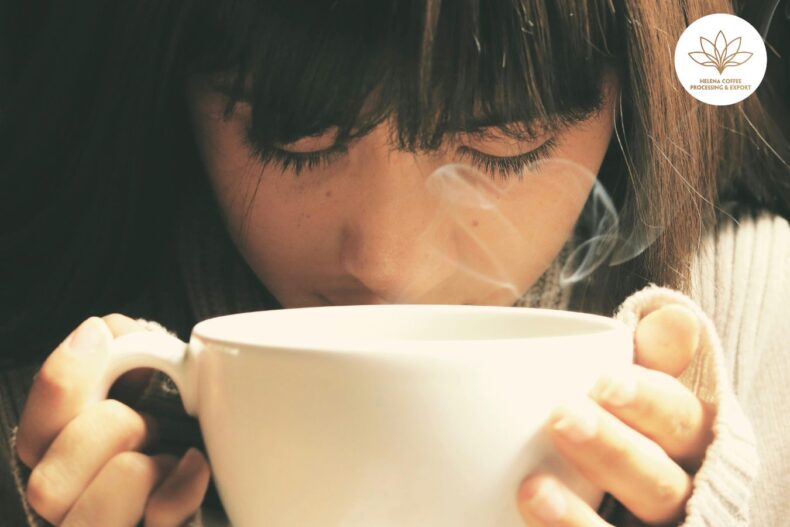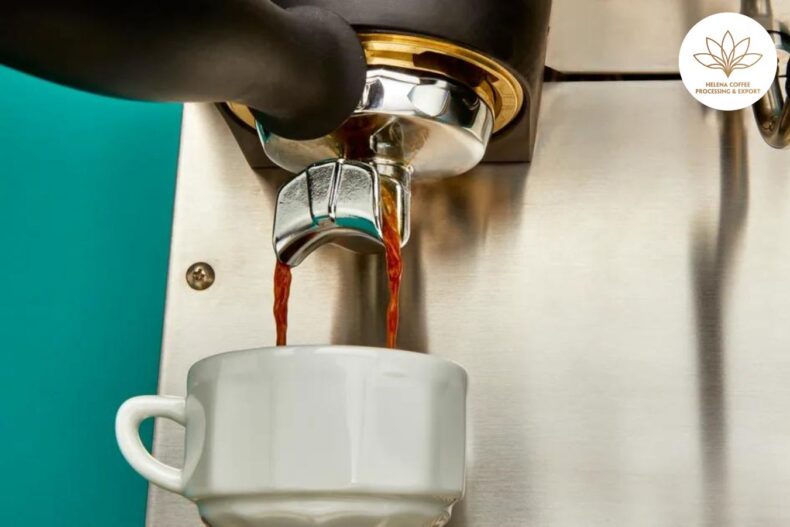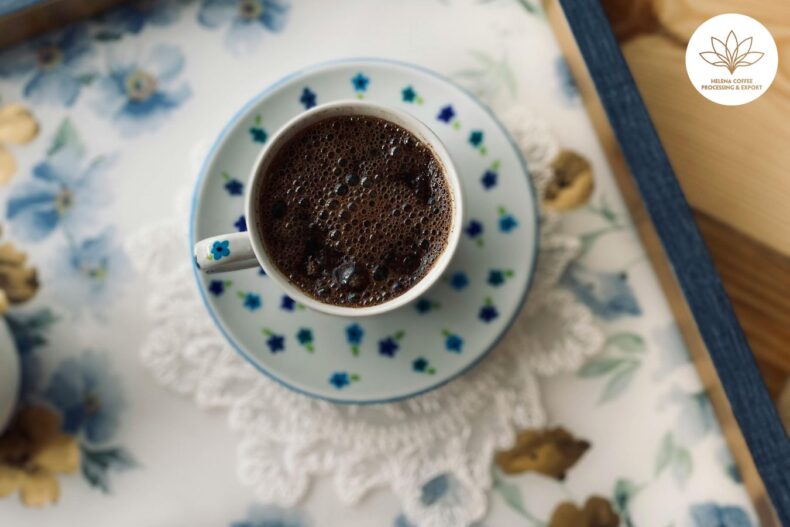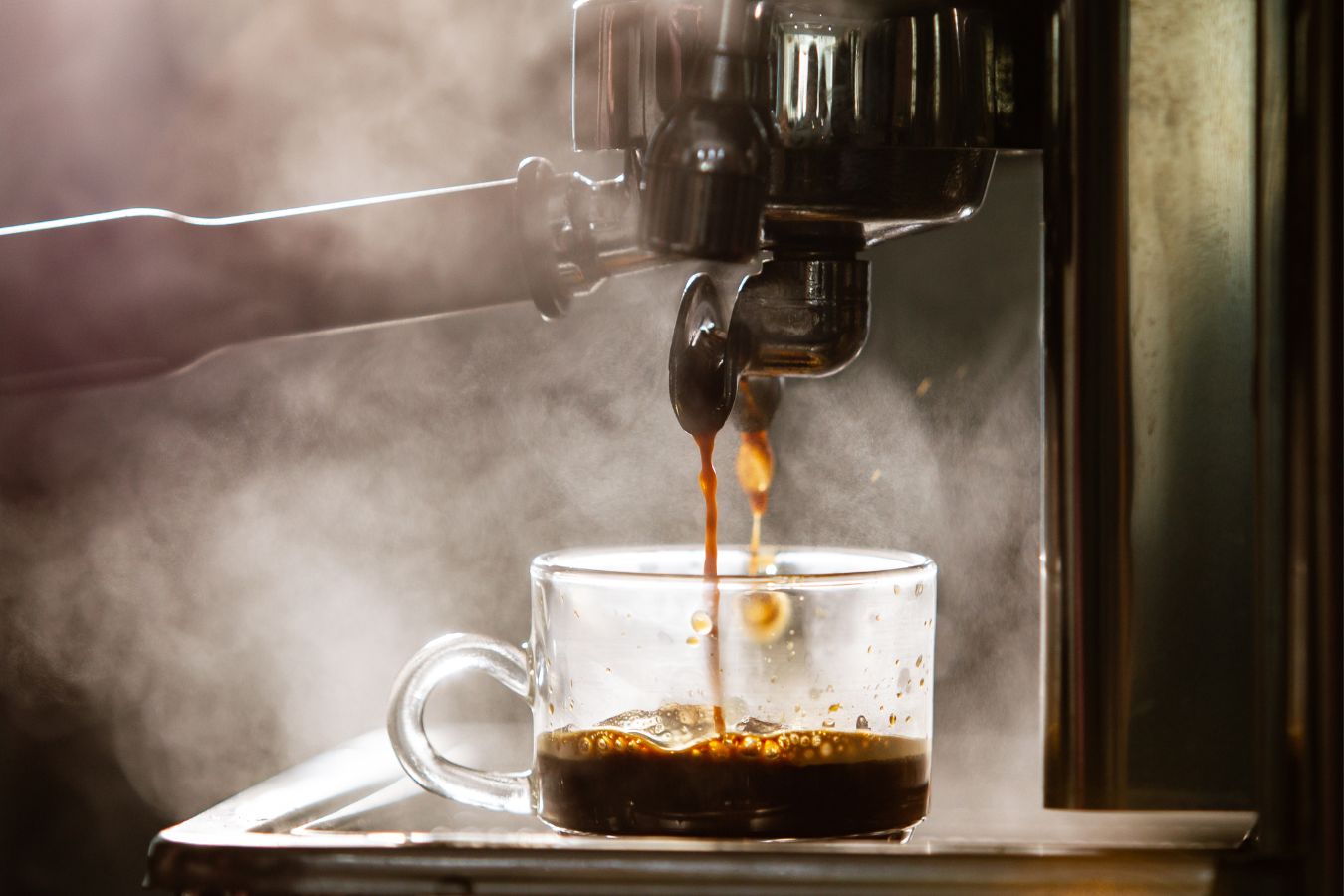
Ristretto, Espresso and Lungo: We are probably familiar with the concept of an Espresso shot with a volume of 25-30 ml extracted under 9 bar pressure for a short period of time. So what about Ristretto Coffee and what is the difference between these three drinks?
Finding a wonderful mix of coffee beans is only the first step in the never-ending search for the ideal caffeinated beverage. Finding the proper method for making this mix is also necessary.
By indicating how many espresso shots they want in their coffee drink, many individuals may alter the flavor and caffeine content of it. Try ordering ristretto as one of the tiny tips for discovering your go-to coffee beverage.
1. Definitions of Ristretto, Espresso and Lungo
You might not be aware of what a ristretto is unless you work as a barista. It’s a concentrated form of espresso, to put it briefly.
We will first describe the process for making espresso before defining the distinction between an espresso, a lungo and a ristretto. You might be shocked by how much you want to try a ristretto after understanding the distinctions!
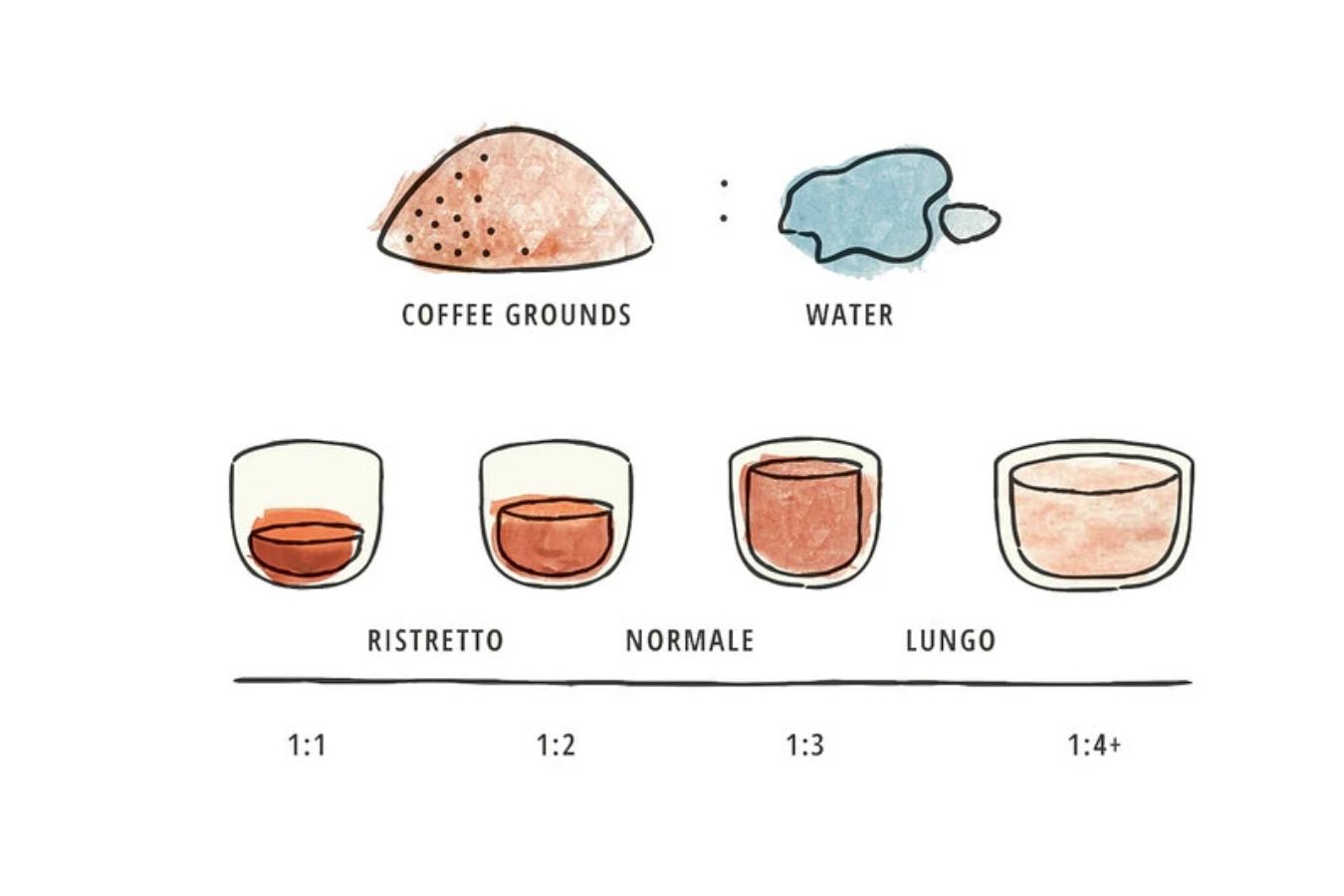
1.1. What are regular espresso shots?
Let’s begin with the fundamentals. A shot of espresso is made up of one to three ounces of highly concentrated coffee. The espresso maker pushes hot, pressured water through tamped (packed) grounds to produce shots of espresso.
This brings out the strong flavors that give espresso its unique flavor. Depending on the machine’s settings and calibrations, the extraction process takes 20 to 30 seconds.
Numerous clients want a double shot of espresso, often known as a doppio, and some even request triple shots.
1.2. What is Ristretto Coffee?
Ristretto is a variation of Espresso or another brewing method using a machine to produce a more “concentrated” cup of coffee.
In Italian, Ristretto means shortened – restricted. “Shorten” here means that baristas only perform extraction at the beginning of a coffee brewing process, leaving out the final extraction stage.
Ristretto shot with a water ratio
Depending on the recipe of the cafe, the Ristretto will range from 15-20ml of coffee. But most are served double shots due to too little volume.
- A ristretto shot is smaller because it uses half as much water as a standard shot. A ristretto shot weighs 0.75 oz compared to a conventional shot’s 1 oz.
- Flavor: A ristretto shot has a shorter extraction period, which results in a more concentrated, stronger flavor. In addition, it finishes sweeter than espresso.
- Level of Caffeine: Fewer extraction results in less caffeine. A ristretto shot has somewhat less caffeine than an espresso shot, despite the minor difference.
1.3. What is Lungo Coffee?
Coffee Lungo is another new version of the espresso drink. Lungo is an Italian word that means long, so in Lungo coffee, the brewing time is longer, along with the amount of water used to make one cup more than in regular espresso.
In a regular espresso, the water content is about 30ml for one cup and is extracted in about 10-30 seconds. But in a glass of Lungo, those two ingredients double.
The recognizable results are that the aroma and taste of lungo are more bitter, with perhaps less caffeine content depending on the beans used and the longer preparation time.
It should not be confused with an Americano even though it is an espresso with a special amount of hot water added to the cup.
Espresso has been constantly changing over the past century. Some baristas have extended espresso extraction to many other variables. And as you can see, in the range 1:3 to higher, we have another variant of Espresso, which is Lungo.
Technically extracted, it is the opposite of Ristretto. Instead of using less water, you have to use more and prolong the extraction time. This can lead to a lot of bitterness because the water has over-exploited the necessary substances in the coffee.
1.4. Ratio of Ristretto, Espresso and Lungo
Each coffee variety has a different flavor potential, depending on the geographical location, the way it is grown and harvested, and the roasting method.
So, choosing the type of coffee and understanding the basic proportions allows you to get closer to the coffee flavor you desire.
We have a simple and memorable Ristretto, Espresso ratio table (as shown) and for comparison, try making coffee shots in this ratio, taste them to see the difference. Of course, this is not all about the espresso ratio. Depending on the region and culture, there will be different ratios of espresso.
- Ristretto. 1:1 to 1:2
- Espresso. 1:2 to 1:3
- Lungo Espresso. 1:3 to 1:4
2. The taste profile of Ristretto, Espresso, and Lungo
2.1. The taste profile of Ristretto
The biggest and most important difference between Ristretto and Espresso is the taste.
Although when discussing the taste depends on many other factors of coffee such as geographical location, roasting, and coffee quality, in general, between 1 cup of Espresso and Ristretto when extracted from 1 cup of coffee.
The same source of coffee will give two completely different flavors.
At first, you will feel the mellow flavor, but the taste is lighter (quite similar to Cold Brew). Next, the acidity, and sweetness are very balanced, and finally a little bit of bitterness.
Visually, Ristretto coffee has a more intense and richer flavor (heavy body) than Espresso.
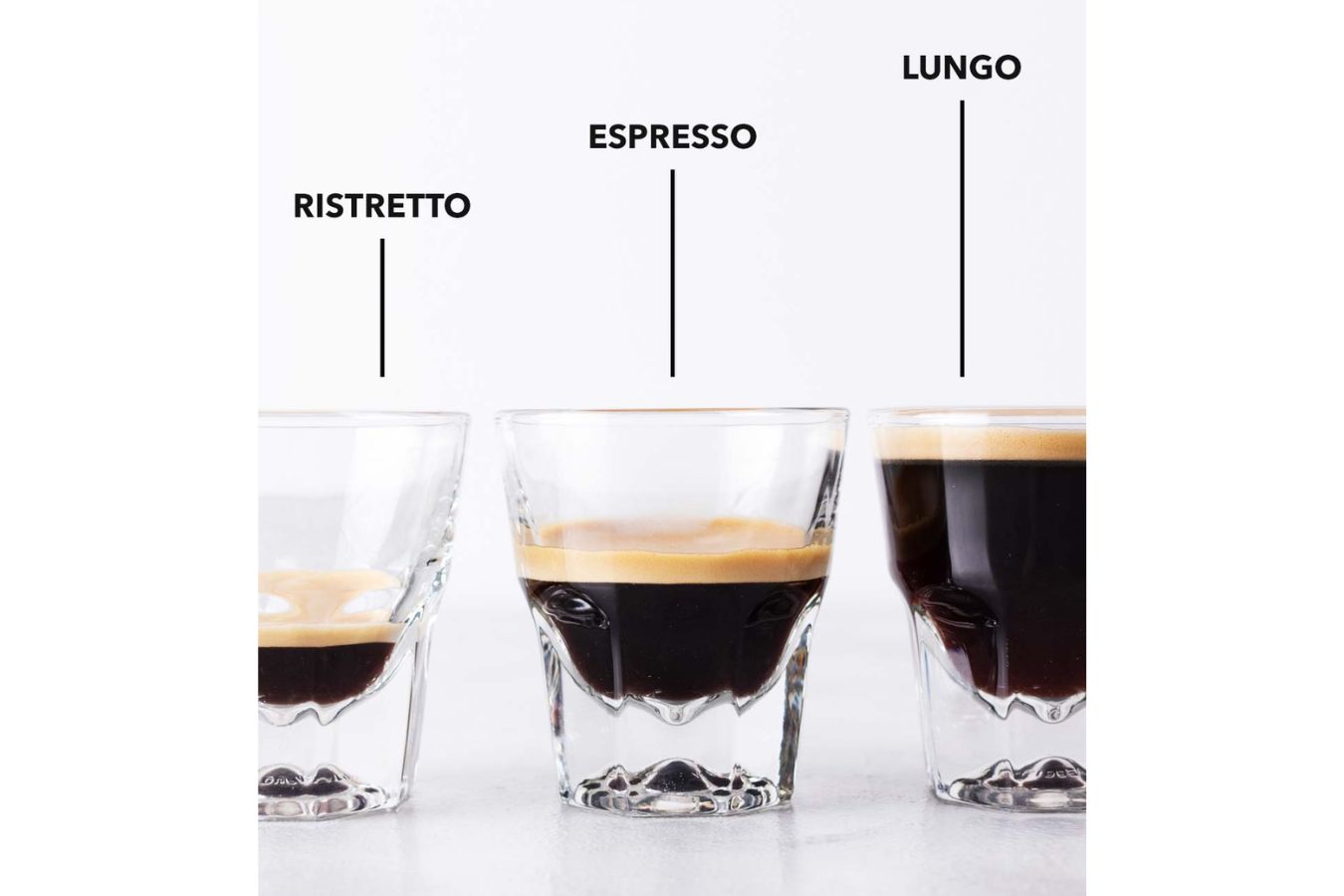
But when extracting Ristretto, you don’t always get an intense and rich cup. Sometimes it’s Under Extracted coffee cups.
Because when making Ristretto coffee, we have cut the amount of water in half and shortened the extraction time, so there will be cases where the water is not enough and does not penetrate into the coffee powder that has been pushed out.
The cup of coffee will be too sour, and quite uncomfortable.
Therefore, the grind size and coffee brewing time need to be strictly controlled. However, on the other hand, acidity is not necessarily indicative of a bad cup of coffee.
In fact, if you use lightly roasted coffee, it will still be richer in acidity and bring out the original coffee flavors such as fruity aromas.
As best as possible, use the right recipe and the right coffee for Ristretto
In essence, the same extraction process for an espresso is used to make a ristretto shot, but with less water.
You must ground the beans a little more finely than normal to reduce the flow of hot water during the extraction if you wish to brew your ristretto at the same time as an espresso.
It turns out that only fifteen seconds of extraction will produce a drink that is considerably softer and much sweeter and may be consumed on its own. The extra fifteen seconds of extraction is where an espresso gets its acidity and bitterness.
As a result, if you’ve ever heard someone at your favorite coffee shop order a Ristretto (or more frequently a Double Ristretto, which has the same volume as a standard espresso (30 ml), they’re getting a very different beverage than those who ordered a regular espresso or had their shot added to their preferred coffee drink. By all accounts, it is a better product.
2.2. The taste profile of Espresso
The common Espresso is certainly something you are acquainted with. It is known for its strong flavor, bitterness, and acidity and is the “base” or default beverage at coffee shops all around the world.
It may be consumed on its own, as a shot, or combined with almost any other coffee beverage to give your beverage an extra boost of caffeine.
2.3. The taste profile of Lungo
The Lungo’s flavor isn’t as intense or concentrated as espresso because of the additional water. But since it was extracted over a longer period of time, it is more acidic and harsh.
Your own choice will ultimately determine which espresso kind you prefer. Some individuals enjoy strong, powerful coffees; others favor the bitter flavor, which is occasionally tempered by sugars or other substances; yet others choose the Ristretto’s gentler flavor.
3. Ristretto, Espresso, and Lungo: Which Should You Choose?
Ristretto |
Espresso |
Lungo |
|
|
|
If you like a strong cup of coffee, choose Ristretto. In contrast, Espresso will give you a fuller experience of flavors, including bitterness.
On the other hand, if you make Cappuccino from Ristretto coffee, you will get a very special cup of coffee, simply because the milk will diffuse the aroma from the Ristretto more.
4. How to make Ristretto, Espresso, and Lungo at home
4.1. How to make Ristretto at home?
- Put ground coffee in your portafilter and tamp it down.
- Pull one or two ristretto shots.
- Use a scale to weigh the amount of coffee that is pulled rather than extracting a typical espresso shot. Plan on 15-20 ml. Serve and consume right away.
BARISTA’S Notes: Check the amount of liquid in your cup to determine whether it is a ristretto shot. Knowing how much space a typical photo occupies can help you make visual comparisons.
4.2. How to make Espresso at home?
- Grind the coffee: Grind ½ cup dark roast coffee beans to a medium-fine grind.
- Heat the water too hot but not boiling (200 to 205°F) using 34 cups plus 2 teaspoons of water.
- After adding coffee, wait 4 minutes: The French press should now contain the medium finely ground espresso coffee. Add boiling water on top and stir. Wait 4 minutes after setting a timer.
- Plunge: Set the French press’s cover on top and gradually press the plunger all the way down.
4.3. How to make Lungo at home?
- Modify the Grind. For a typical espresso, we typically use 18 grams of coffee and a grind setting of 9 or so on the Breville Barista Pro.
- Make the coffee.
- Tamp, Level Coffee.
- Secure Portafilter and start brewing.
- Make a Long Shot.
- Complete the shot pull.
- Enjoy Your Lungo
FAQs:
- What are regular espresso shots?
- pressurized hot water
- concentrated espresso coffee and highly concentrated espresso
- espresso lungo ristretto with lower caffeine content
- forcing pressurized hot
- black coffee made and lungo definition espresso
